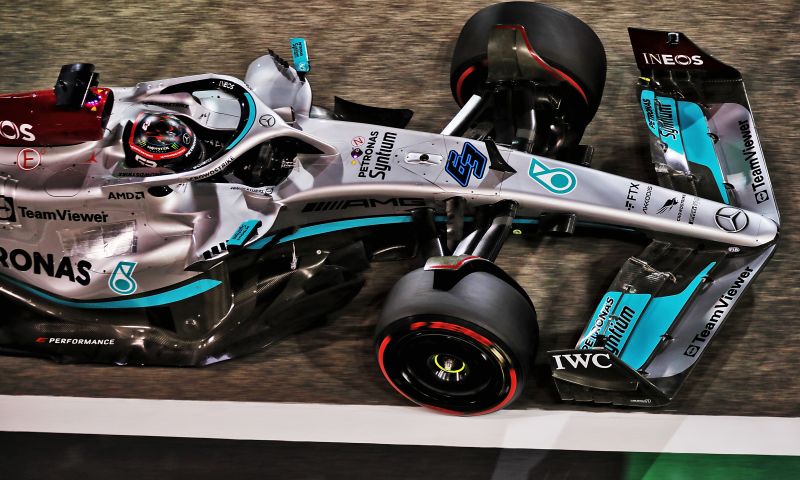Mercedes' sandbagging history: A look back at the past five years
Column

- Rafael Diaz Lehmann
Formula 1 Pre-Season Testing has just wrapped-up in 2022 with Mercedes looking to be struggling with their car yet again... Or are they? When it comes to pre-season testing, any conversation about Mercedes is almost certain to have the word ‘sandbagging’ thrown in there. In recent years, the purposeful murkiness of the Silver Arrows’ performance in testing has become as infamous as their utter dominance of the sport. But how did this reputation of sandbagging and hiding pace come about in the first place? In this piece we will look through the past five years of pre-season testing and the history of Mercedes’ sandbagging.
2017
In 2017 it looked like Ferrari were the class of the field in testing. Kimi Raikkonen had set the fastest lap in Barcelona with a 1:18.634, 1.3 seconds faster than the Mercedes of Valtteri Bottas. Lewis Hamilton was speaking to media outlets touting how Ferrari were undoubtedly the fastest car, and that the Italian squad were hiding their true pace. Everything looked set to be a great season for the Scuderia.
However, once the first round of the championship came by, the illusion was shattered. Lewis Hamilton qualified on pole position in Australia and was certain to win the race before a slow Max Verstappen held him up enough to give his rival Sebastian Vettel the overcut into the lead.
While Ferrari weren’t miles off Mercedes that year, it was nowhere near the advantage that the Silver Arrows touted them to have after testing. Ultimately it was Hamilton and Mercedes that both won the championship that year in the third-to-last round in Mexico.
2018
Moving forward to 2018, it looked more of the same. Ferrari once again looked quick with Sebastian Vettel setting the fastest time of testing with a 1:17.182. However, this year Mercedes only set fast laps on the hardest compound of tyres, showing themselves as the seventh fastest team on the ‘overall fastest laps’ sheet. This attempt to hide their pace, however, was seen through by all the teams, who spotted the rapid long-run pace of the W09. However, there was hope that Ferrari could challenge the Silver Arrows.
Once again, the true pace of the Mercedes was revealed in Australia. Lewis Hamilton outqualified both Ferraris by seven-tenths of a second, taking a commanding pole position. The Brit lost out on the win to Vettel yet again during the race due to an untimely Virtual Safety Car, but that did not stop him and Mercedes from taking both the Driver’s and Constructors Championships once more.
2019
This was the year. Ferrari looked mighty in testing, so mighty. Fastest lap. Fast in all of the long runs. They were the clear favourites. Everyone had them placed at their number one spot. Lewis Hamilton and Mercedes were saying that the gap to Ferrari was half-a-second. Sebastian Vettel and Charles Leclerc looked so confident in what their year could be.
Unfortunately for them, it was all a lie. When they rocked up to Australia, Hamilton and Bottas locked-out the front row and out-qualified the Ferrari of Vettel by seven-tenths of a second once more. This time Mercedes kept their form and won the race, Bottas taking the checkered flag 20 seconds ahead of anyone else. The Silver Arrows then went on to take first and second in the first five races, a new record in the sport.
Unsurprisingly, Mercedes and Hamilton went on to win the championship, with the opposition nowhere near close. Mercedes’ reputation for sandbagging in testing had been established.
2020
In 2020, Mercedes’ superiority was to such a level that it couldn’t be hidden. Bottas set the fastest lap in testing, and once the Silver Arrow’s ‘DAS’ device was revealed to the world, all the other teams knew that the W11 was a different beast.
The Silver Arrows won 13 out of the 17 races that year, leading to Lewis Hamilton claiming his record-equaling seventh world title and Mercedes winning their record-breaking eighth constructors’ title in a row. The 2020 Mercedes W11 is undoubtedly the fastest-ever F1 car, a testament to the Brackley-based team’s superiority of the sport.
2021
2021 seemed different. After the dominant season of 2020, nobody expected Mercedes to suddenly be struggling with stability in testing, causing Lewis Hamilton to spin on several occasions. Red Bull looked like they finally developed a car worthy of Max Verstappen’s talent, setting the fastest time in testing and looked to have the upper hand on the field. Could this be the year that Mercedes would finally be beaten?
Come qualifying, Verstappen and Red Bull had done it. Pole position by four tenths of a second to Hamilton, it looked like a worthy opponent to the Mercedes’ had appeared. However, in the race, it was Hamilton who outdueled the Dutchman for the win. What commenced was one of the most exciting seasons in F1’s history, with Hamilton and Verstappen trading wins. While it was Verstappen who would ultimately come away with the driver’s championship, it was Mercedes that claimed the constructors’ again.
Despite the testing ‘troubles’, Mercedes had bested them all once again.
2022?
That brings us to now, where Mercedes are looking to be the third-best team on the grid, behind Ferrari and Red Bull... Or so they say. History tells us we shouldn’t always trust what they say about pre-season testing, but we’ll only know for sure where they lay, once the flag drops in Bahrain this Sunday.